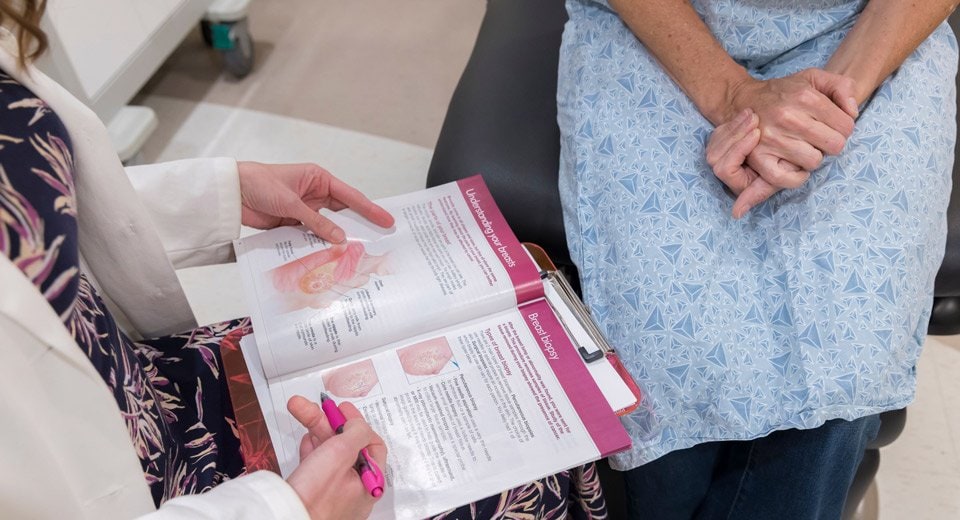A primer on breast cancer staging and treatment

When I was diagnosed with ductal carcinoma in situ (DCIS), a stage 0 breast cancer almost 25 years ago, it was a devastating diagnosis, particularly as a single parent with two junior high school-age children. Even though I am a nurse, this was not my area of practice and I did not know what to expect.
I was told my treatment would be a lumpectomy to remove the cancer, followed by six weeks of radiation therapy. The oncologist, breast surgeon and radiation oncologist as well as their team were very supportive, explained the treatment and offered me reassurance with every step.
While the radiation left me very fatigued and I faced some difficult personal challenges, I am very grateful for the treatment that put my cancer into remission.
“A lot of patients present with early-stage breast cancer 0-2, and even though it is scary and stressful, I tell them this is early, this is curable, and keep that in the back of your mind as you move forward with all of your treatments,” said Naomi Kalliath, DO, a breast surgeon at the Cuda Breast Care Center at CCHC and Falmouth Breast Care Center at CCHC.
“Most of the time, thankfully, we can detect breast cancer with screening mammograms at the earliest stages, stage 0 and stage 1, both of which are very common,” she said. “Stages of breast cancer range from 0 to 4, all of which are treatable, with stages 0 to 3 being curable. While it can be very sad when a woman is diagnosed with stage 4 breast cancer, it doesn’t mean there isn’t any treatment, because there is.”
How Breast Cancer is Staged
Staging of breast cancer determines how large the tumor is, if the cancer has spread to nearby lymph nodes and whether it has spread to a different part of the body, according to the National Cancer Institute.
“The prognostic staging of breast cancer is based on the TNM system,” said Dr. Kalliath. “It refers to tumor size. ‘N’ refers to the number of lymph nodes involved by the cancer, and ‘M’ refers to distant metastatic disease meaning the cancer has spread to other parts of the body.”
The other consideration that goes into staging is the type of breast cancer, she said. Not all breast cancers are the same.
Dr. Kalliath described the types of breast cancer as:
- More common breast cancers are fueled by the hormone's estrogen and progesterone.
- If the tumor contains estrogen receptors, the cancer is called ER (estrogen receptor) positive.
- If the tumor contains progesterone receptors, it is called PR (progesterone receptor) positive.
- If the cancer is not fueled by estrogen or progesterone, it is called ER negative and PR negative. When they lack both hormone receptors, they are called HR (hormone receptor) negative.
- There are also HER2-positive cancers fueled by a protein called HER2/neu.
- Less common breast cancers are triple negative breast cancers. They are not fueled by estrogen, progesterone or HER2/neu.
- HER2-positive and triple negative breast cancers tend to be more aggressive.
Types of Treatment
There are three ways of treating breast cancer, according to Dr. Kalliath:
- Surgery
- Radiation Therapy
- Systemic Therapy
Surgery
“Surgery is almost always a given and that depends how big the breast cancer is in relation to their breast size,” she said. “This determines if they will have a partial mastectomy, also called a lumpectomy, or a total mastectomy (removal of the entire breast).
The other consideration when deciding on surgery is the lymph node status, Dr. Kalliath said. If there is cancer in the lymph nodes already, the surgeon may need to perform an axillary dissection to remove all the lymph nodes. If there is no lymph node involvement, but there is stage 1 cancer or greater, then the lymph nodes are sampled and only a few are removed with a sentinel node biopsy.
Radiation
“Radiation therapy almost always happens a few weeks after surgery in the setting of a partial mastectomy or if cancer spread to the lymph nodes,” said Dr. Kalliath. “The main goal is to reduce the risk of local recurrence and in many cases, radiation also improves survival.”
Systemic Treatment
“Systemic treatment is an umbrella term because there are basically two types of therapy that go under the umbrella,” she said. One common type of treatment is endocrine therapy, which is an anti-hormone medication in pill form such as Tamoxifen and Anastrozole for hormone-positive breast cancer patients. The second form is chemotherapy. Patients who have more aggressive breast cancer like HER2 positive or triple negative breast cancers usually need chemotherapy. In hormone-positive breast cancer, genomic profiling test of the tumor may also be done to determine if chemotherapy will benefit that patient too, she said.
“The treatment of breast cancer has come such a long way in the past 20 years,” said Dr. Kalliath “Survival has increased dramatically, and I credit Breast Cancer Awareness that brings attention to the importance of screening mammograms which result in early detection and therefore lead to improved survival. Breast self-awareness and knowing what is abnormal for you is also key in early detection.”
